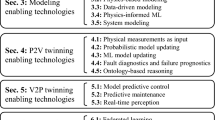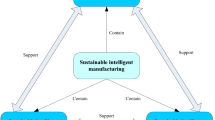Abstract
An integrated concurrent engineering methodology for developing a baby carriage is proposed. The development process is divided into three stages for considering the design, manufacture, and assembly problems. The product is first designed based on design criteria to ensure the best matching of needs and requirements. Then the parts and machine tools are coded using group technology (GT). The machine groups and the parts to be processed are given in matrix form using the production flow analysis (PFA) method. The machine cells are arranged based on the balance analysis of process time, and a flexible manufacturing system (FMS) is planned. Finally, the assembly line is planned based on the relationship of the parts. Some related parts are collected as a subassembly system. After the subassembly is decided, the work stations are arranged based on the required assembly time to obtain a high-performance assembly line. The results show that not only is the production cost of the product reduced, but also that the competitive properties are improved. This model can also be applied to develop other products.
Similar content being viewed by others
References
C. W. Allen,Simultaneous Engineering Integrating Manufacturing and Design Society of Manufacturing Engineers, Michigan, 1990.
G. Boothroyd and P. Dewhurst,Product Design for Assembly, Boothroyd Dewhurst, Wakefield, 1989.
M. Sweeney, “How to perform simultaneous process engineering”,Integrated Manufacturing System 3(2), pp. 15–19, 1992.
I. Ham, K. Hitomi and Y. Yoshida,Group Technology, Kluwer Nijhoff Publishers, Hingham, MA, 1985.
A. Opitz and H. P. Wiendahl, “Group technology and manufacturing systems for minimum quantity production,”International Journal of Production Research 9(1), pp. 181–203, 1971.
A. C. Lin and T. C. Chang, “Framework for automated mechanical assembly planning”,Journal of Mechanical Working Technology 20 pp. 237–248, 1989.
Y.-Q. Lee and S. R. T. Kumara, “Individual and group disassembly sequence generation through freedom and interference spaces”,Journal of Design and Manufacturing 2, pp. 143–154, 1992.
M. Shpitalni, G. Elber and E. Lenz, “Automatic assembly of three-dimensional structures via connectivity graphs”,Annals of CIRP 38(1), pp. 25–28, 1988.
H. Ko and K. Lee, “Automatic assembling procedure generation from mating conditions”,Computer-Aided Design 19(1), pp. 3–10, 1987.
P. K. Khosla and R. Mattikali, “Determining the assembly sequeence from a 3-D model”,Journal of Mechanical Working Technology 20, pp. 153–162, 1989.
J. T. Black, “An overview of cellular manufacturing systems and comparison to conventional system”,Industrial Engineering, pp. 36–48, November 1983.
I. Zeid,CAD/CAM Theory and Practice, McGraw-Hill, New York, 1991.
Luiz S. Homem de Mello and S. Lee,Computer-Aided Mechanical Assembly Planning, Kluwer Academic Publishers, Boston, 1991.
Author information
Authors and Affiliations
Rights and permissions
About this article
Cite this article
Hsiao, SW. A concurrent engineering based method for developing a baby carriage. Int J Adv Manuf Technol 12, 455–462 (1996). https://doi.org/10.1007/BF01186935
Issue Date:
DOI: https://doi.org/10.1007/BF01186935




